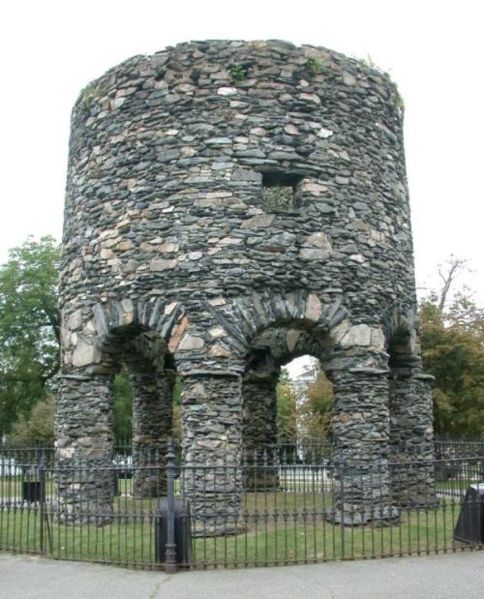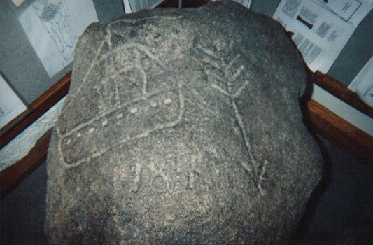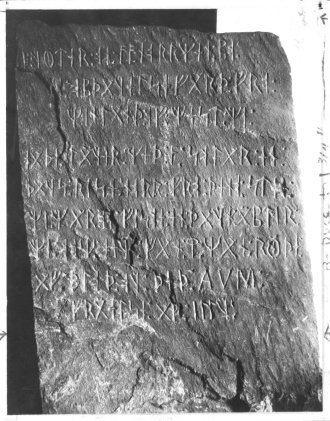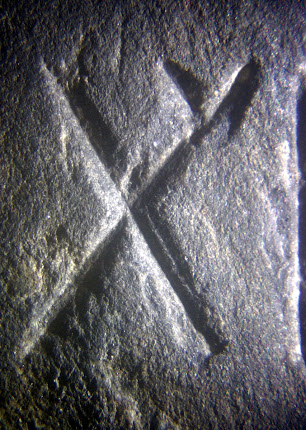In late June I posted some images of what appear to be a Hooked X or Forked X on the Westford Knight carving. On August 31 researcher Jerry Lutgen, along with geologist Scott Wolter, came to Westford to photograph and examine the mark. I won't try to describe Jerry's work other than to say he uses digital imaging to create 3D images and models of the carvings he studies. Here is a color image of the Hooked X mark:
As Jerry explained it to me, because the rock is not a flat surface, the thing to focus on here is the comparative depth of the lines in question, not their absolute depth. What we are looking for is a consistency in the relative depth of the lines in question (this consistency shows a manmade origin rather than a naturally occurring one).
Looking at the X (you may need to zoom in), the "hook," and the 2 "word separator" dots on either side, we see that the upper left stem, the lower left stem, the upper right stem, the "hook" stem and the left dot all contain light blue "punch" marks within the green-colored surface. The lower right stem and the right dot are solid green amid the yellowish/orange-colored surface. Looking at the color chart on the right of the image, we see that all the carved lines/dots in question are approximately one to one-and-a-half color gradations in depth--in other words, carved or punched at a relatively similar depth. Again, this points to a manmade origin.
We can next compare the Hooked X mark with the sword portion of the carving:
This sword area is a relatively flatter surface, and we see that the punch marks are mostly light green amid a yellowish surface (around the pommel) or dark green amid a light green surface (near the cross-guard). Again, we have a carved/punched depth equal to approximately one color gradation.
Scott Wolter has not reviewed all the data yet, but he and I had a long telephone conversation on September 26 and his preliminary conclusion is that it is 85-90% likely that the mark is indeed a manmade Hooked X carved at a time contemporaneous to the sword carving. As I understand it (and Scott has not reviewed this post), this conclusion is based on the following factors:
1. The orientation of the mark is perfectly consistent with the orientation of the rest of the carving.
2. The "word separator" dots are equally spaced on either side of the mark and positioned similarly to separator dots in other runic carvings.
3. The carving depth is consistent within the Hooked X itself and also consistent as between the Hooked X and the sword (see above).
4. The weathering profile within the Hooked X mark is consistent with the weathering within the sword carving.
5. It is extremely unlikely that a Hooked X mark and a pair of separator dots, all appearing in the proper orientation, would somehow naturally form on the face of the Westford Knight carving.
When I asked Scott why this only added up to 85-90% certainty, he laughed and said that his only hesitation was that finding a Hooked X on the Westford Knight carving was simply "too good to be true."
The Newport Tower

Medieval stone tower ... in Rhode Island. Does it look like any other Colonial structure you've seen? Recent carbon dating of the mortar indicates 1400s construction date (see post below).
The Westford Knight Sword
Medieval Battle Sword ... in Westford, Massachusetts. Can anyone deny the pommel, hilt and blade punch-marked into the bedrock?
The Spirit Pond Rune Stone
Medieval Inscription ... in Maine, near Popham Beach. Long passed off as a hoax, but how many people know the Runic language? And how is it that some of the Runic characters match rare runes on inscriptions found in Minnesota and Rhode Island? Carbon-dating of floorboards at nearby long house date to 1405.
The Narragansett Rune Stone

Medieval Inscription ... in Rhode Island's Narragansett Bay. This Runic inscription is only visible for twenty minutes a day at low tide--is this also the work of a modern-day, Runic-speaking hoaxster?
The Westford Boat Stone

Medieval Ship Carving ... in Westford, MA. Found near the Westford Knight site. Weathering patterns of carving are consistent with that of 600-year-old artifact. And why would a Colonial trail-marker depict a knorr, a 14th-century ship?
The Kensington Rune Stone

Medieval Inscription... in Minnesota. Forensic geology confirms the carvings predate European settlement of Minnesota--so did Runic-speaking Native Americans carve it?
The Hooked X Rune

Medieval Runic Character ... on inscriptions found in Maine, Minnesota and Rhode Island. But this rare rune was only recently found in Europe. This conclusively disproves any hoax theory while also linking these three artifacts together.
Tuesday, October 7, 2014
Subscribe to:
Post Comments (Atom)


1 comment:
Excuse me, but if this story is false, then I would not exist! My name is Susan Robinson, and I am the American descendant (Robins' son) of Gunnr & Ragnihild of Caitness.
surob800@gmail.com
Post a Comment